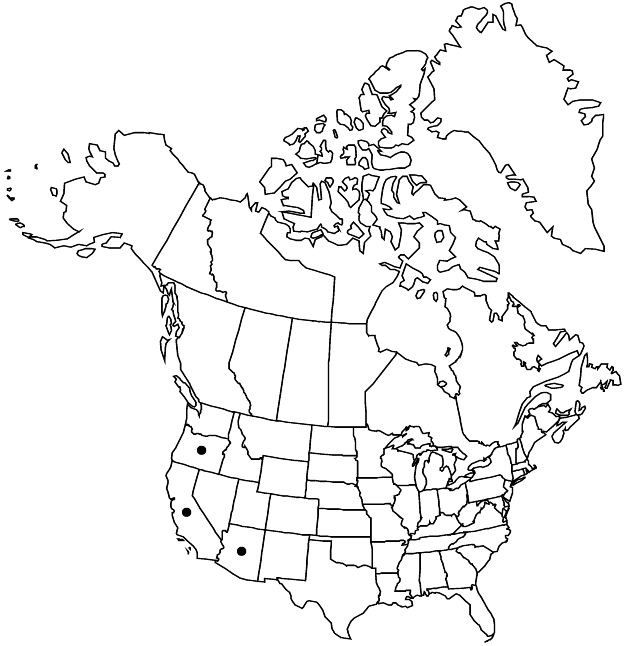Difference between revisions of "Cercocarpus betuloides"
in J. Torrey and A. Gray, Fl. N. Amer. 1: 427. 1840.
FNA>Volume Importer |
RevisionBot (talk | contribs) m (Bot: Adding category Revised Since Print) |
||
| (3 intermediate revisions by 2 users not shown) | |||
| Line 1: | Line 1: | ||
{{Treatment/ID | {{Treatment/ID | ||
|accepted_name=Cercocarpus betuloides | |accepted_name=Cercocarpus betuloides | ||
| − | |accepted_authority=Nuttall | + | |accepted_authority=Nuttall |
|publications={{Treatment/Publication | |publications={{Treatment/Publication | ||
|title=in J. Torrey and A. Gray, Fl. N. Amer. | |title=in J. Torrey and A. Gray, Fl. N. Amer. | ||
| Line 23: | Line 23: | ||
-->{{Treatment/Body | -->{{Treatment/Body | ||
| − | |distribution= | + | |distribution=Ariz.;Calif.;Oreg.;nw Mexico. |
|discussion=<p>Varieties 3 (3 in the flora).</p><!-- | |discussion=<p>Varieties 3 (3 in the flora).</p><!-- | ||
--><p>The western, spring-flowering <i>Cercocarpus betuloides</i> in the broad sense, centered in California, is well supported by molecular data. A total of five taxa have been recognized in recent floras; molecular data provide no support for these taxa, but instead support recognition of a single inclusive taxon.</p> | --><p>The western, spring-flowering <i>Cercocarpus betuloides</i> in the broad sense, centered in California, is well supported by molecular data. A total of five taxa have been recognized in recent floras; molecular data provide no support for these taxa, but instead support recognition of a single inclusive taxon.</p> | ||
| Line 56: | Line 56: | ||
-->{{#Taxon: | -->{{#Taxon: | ||
name=Cercocarpus betuloides | name=Cercocarpus betuloides | ||
| − | |authority=Nuttall | + | |authority=Nuttall |
|rank=species | |rank=species | ||
|parent rank=genus | |parent rank=genus | ||
| Line 62: | Line 62: | ||
|basionyms= | |basionyms= | ||
|family=Rosaceae | |family=Rosaceae | ||
| − | |distribution= | + | |distribution=Ariz.;Calif.;Oreg.;nw Mexico. |
|reference=None | |reference=None | ||
|publication title=in J. Torrey and A. Gray, Fl. N. Amer. | |publication title=in J. Torrey and A. Gray, Fl. N. Amer. | ||
|publication year=1840 | |publication year=1840 | ||
|special status=Illustrated | |special status=Illustrated | ||
| − | |source xml=https:// | + | |source xml=https://bitbucket.org/aafc-mbb/fna-data-curation/src/2e0870ddd59836b60bcf96646a41e87ea5a5943a/coarse_grained_fna_xml/V9/V9_546.xml |
|subfamily=Rosaceae subfam. Dryadoideae | |subfamily=Rosaceae subfam. Dryadoideae | ||
|tribe=Rosaceae tribe Dryadeae | |tribe=Rosaceae tribe Dryadeae | ||
| Line 74: | Line 74: | ||
}}<!-- | }}<!-- | ||
| − | -->[[Category:Treatment]][[Category:Cercocarpus]] | + | --> |
| + | |||
| + | [[Category:Treatment]] | ||
| + | [[Category:Cercocarpus]] | ||
| + | [[Category:Revised Since Print]] | ||
Latest revision as of 19:10, 6 November 2020
Shrubs or trees, 10–50(–80) dm, sparsely to moderately branched, young stems, leaves, pedicels, and hypanthia sericeous (hairs straight, antrorse, appressed, or ± ascending), or hirsute-pilose (hairs erect, straight), or ± villous (hairs wavy or wavy-crinkled), or hairs tightly coiled or 1/2 coiled, or 1/2 coiled at base and erect-ascending, wavy distally, 0.2–0.8(–1.3) mm. Stems: long-shoot internodes 3–20(–55) mm, ± sparsely hairy, glabrescent; short shoots 3–30(–55) × 1–2.5 mm. Leaves persistent or ± drought-deciduous; stipules (1.5–)3.5–6(–10) mm, 1.5–2.5 mm in s California; petiole 1.5–9(–16) mm; blade oblong-obovate, rhombic, suborbiculate to broadly ovate, rarely oblong-elliptic, (8–)12–50(–78) × (4–)8–35(–64) mm, membranous to coriaceous, base cuneate to rounded, rarely ± cordate, margins ± revolute or flat, dentate, serrate, or, in broader leaves, crenate in distal 1/5–3/4, apex rounded, sometimes acute, abaxial surface sericeous, pilose, villous, or with curled hairs on veins, areoles canescent or glabrous, adaxial sparsely hairy, sometimes glabrate. Flowers 1–18 per short shoot; hypanthial tubes sericeous, woolly, or villous or with coiled or spreading hairs; hypanthial cups 2–4 × 4–7 mm; sepals 5, broadly deltate, 1–2.5 mm, acute-acuminate; stamens 20–61, anthers 1–1.5 mm, hirsute. Achenes 7–11(–13.5) × 1.5–2.5(–2.9) mm; fruiting pedicels (1.5–)3–11(–21) mm; hypanthial tubes (5–)7–13(–17) mm; pedicel/tube ratio (15–)35–90(–126)%; fruit awns 5–8.5(–12.5) cm, proximal setae 2.7–5 mm.
Distribution

Ariz., Calif., Oreg., nw Mexico.
Discussion
Varieties 3 (3 in the flora).
The western, spring-flowering Cercocarpus betuloides in the broad sense, centered in California, is well supported by molecular data. A total of five taxa have been recognized in recent floras; molecular data provide no support for these taxa, but instead support recognition of a single inclusive taxon.
Selected References
None.
Lower Taxa
Key
| 1 | Leaves, young stems, and hypanthial tubes appressed-sericeous or hypanthial tubes also with erect-ascending hairs (hairs not coiled); flowers 1–3(–10) per short shoot; transmontane s, c California, c Arizona, and sw Oregon. | Cercocarpus betuloides var. betuloides |
| 1 | Leaves, young stems, and hypanthial tubes commonly with tightly coiled hairs (except in some insular plants where sericeous); flowers (1–)3–6(–18) per short shoot; cismontane s California | > 2 |
| 2 | Leaf blades sparsely to moderately hairy, subcoriaceous to coriaceous, margins serrate or dentate or crenate in distal 1/5–3/4; coastal s California and adjacent islands. | Cercocarpus betuloides var. blancheae |
| 2 | Leaf blades abaxially densely woolly, strongly coriaceous, margins (often strongly revolute, usually obscuring teeth), crenate, dentate-serrate in distal 1/2–3/4; sw Santa Catalina Island. | Cercocarpus betuloides var. traskiae |